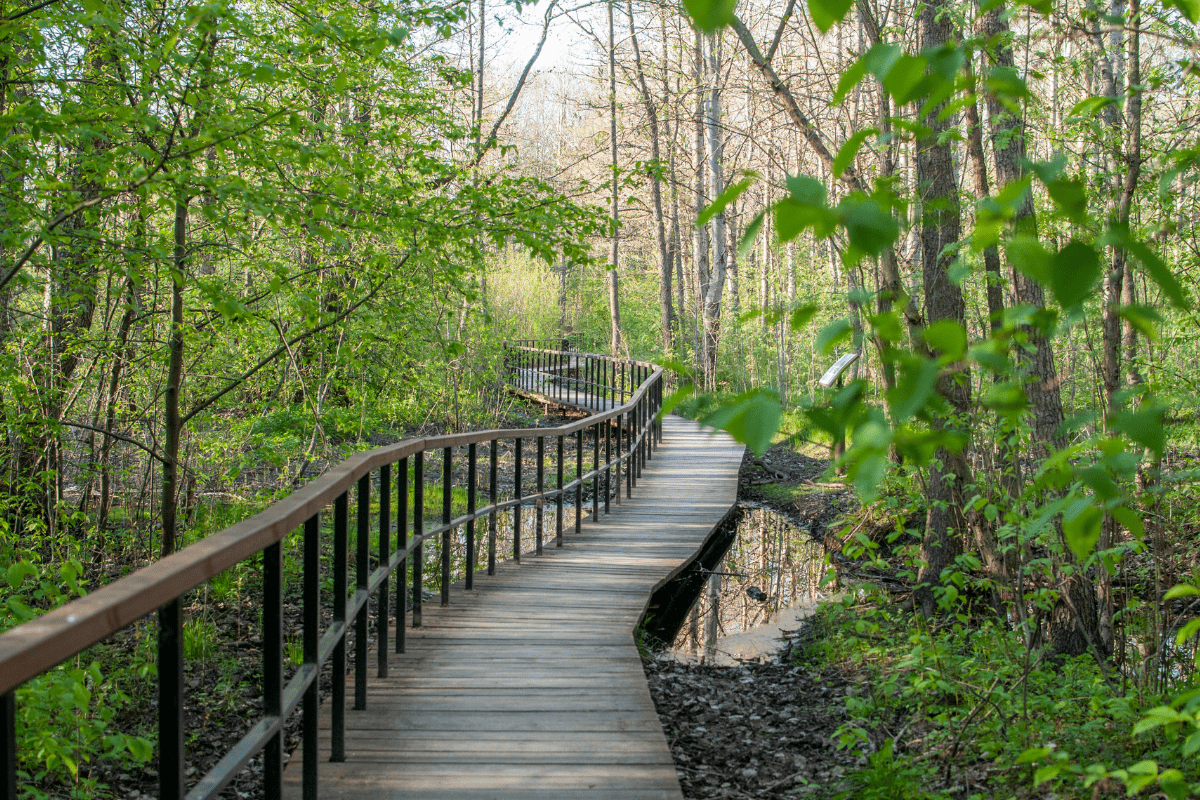If you’re itching to trade traffic noise for the songs of birds and the rustle of palmetto leaves, Port St. Lucie has no shortage of inviting trails. Whether you want a family-friendly stroll, a chance to spot local wildlife, or a lengthy escape on peaceful dirt paths, the area’s parks and preserves deliver easy access to nature right nearby.
Let’s get to it.
Oxbow Eco-Center
Nestled in St. Lucie County, Oxbow Eco-Center covers 225 acres of Florida habitats, including pine flatwoods and sloughs. Nine named trails loop through the preserve, each highlighting a different species. The Gopher Tortoise Trail and Scrub Jay Trail are popular for wildlife sightings. Otter Trail follows a floodplain along the river and often reveals raccoons or river otters.
Accessibility is a priority at the center. All paved paths welcome wheelchairs and strollers. Free all-terrain wheelchair rentals are available at the visitor center. Trails are well-marked and restoration efforts keep the area tidy. Elevated platforms and boardwalks give a clear view of marshes and sloughs.
Dogs on a leash are welcome on main paths. Picnic tables and benches are placed along the routes for breaks. Nearby restrooms and shaded pavilions provide comfort. In summer months, mosquitoes can be active so insect repellent is recommended. Oxbow Eco-Center offers a hands-on experience with Florida’s natural landscapes.
Savannas Preserve State Park
Savannas Preserve State Park covers more than 17 miles of multiuse trails that wind through coastal marshes and pine flatwoods. The White Trail reaches nearly 8 miles of flat terrain. Shade is limited along this route and benches appear at irregular intervals.
Shorter options include the Yellow Trail and Blue Trail, each under 2 miles and easy to find from Walton Road. The Gopher Tortoise Trail follows a grassy path while the Glass Lizard Trail near the education center offers a smooth surface for wheelchairs and strollers.
Birdwatchers may gather at Hawks’ Bluff, especially in January and February. Restrooms are available at the park entrance but not along every trail. Leashed dogs are welcome and waste stations are placed at trailheads. Park staff maintain the paths regularly and clear fallen debris. Savannas Preserve State Park combines varied trail lengths, wildlife habitat, and basic facilities for a flexible outdoor experience.
Woodstork Trail/Hillmoor Lake Park
At Lake Wales, Woodstork Trail in Hillmoor Lake Park offers a 1.27-mile concrete loop that stays flat for all abilities. The path runs close to Hillmoor Lake and features two fishing decks overlooking the water. Visitors often spot woodstorks, herons, turtles, and sometimes an alligator along the shoreline.
Benches appear every few hundred feet, and two ADA restrooms are available near the parking area. The lot sits next to the trailhead so access is straightforward. Fitness stations line the route, and park staff regularly sweep the pavement to remove debris.
Leashed dogs are welcome and waste stations are provided. Weekends bring more walkers early in the morning, while weekdays tend to be quieter by midday. Shady spots under the pines offer relief from direct sun, but water is still essential on hot days. Woodstork Trail combines smooth footing, wildlife views, and reliable amenities for an easy outdoor outing.
Riverwalk Boardwalk
Along the St. Lucie River, the Riverwalk Boardwalk spans roughly half a mile of recycled boardwalk above mangrove wetlands. The surface remains level and secure, making it easy for strollers and wheelchairs. Solar-powered lights line the path for evening visits.
An observation deck looks out over the water, where turtles and occasional manatees appear. Fishing stations and benches offer spots to pause. Restrooms are located at Tom Hooper Park and at Veterans Park near each end of the boardwalk. Leashed dogs are welcome along the entire route.
Free Wi-Fi covers the boardwalk and a live webcam streams river activity. The city maintains the structure and checks for storm damage. Visitors often arrive at sunrise and sunset, and special River Nights events draw extra crowds after dark. The walk remains open around the clock, providing a quiet place to observe wildlife and water traffic under the stars.
Jessica Clinton Park
At Jessica Clinton Park, a paved sidewalk loops around 20 acres of open space. The full circuit measures about three-quarters of a mile and stays lit after dark with working lights. The level path is free of sudden drops, making it smooth for walking, jogging, and rolling underfoot.
Benches and picnic pavilions with water and electrical outlets are spaced around the trail. ADA restrooms are accessible from the main loop. Free public Wi-Fi reaches throughout most areas. Birds and small wildlife often appear along the edge of the grass fields. Neighbors walk their dogs on leash while enjoying the views.
Early mornings bring a cool breeze through the shade trees. Midday, sunlight filters between branches and crosses the open lawns. Dogs on leash are welcome, provided owners use the waste stations. The park never feels crowded, offering a relaxed setting for exercise or a casual stroll. Jessica Clinton Park combines basic amenities, reliable lighting, and quiet scenery for a straightforward outdoor visit.
Spruce Bluff Preserve
Spruce Bluff Preserve packs history and wildlife into a compact area along the river. Two easy trails invite exploration: the 1.3-mile Ais Trail and the 0.5-mile Pioneer Trail loop. Sections of boardwalk carry you above marshes, while dirt paths wind through sand pine and flatwoods. One stretch features coquina shell underfoot—smooth enough for a stroller but not quite a sidewalk.
Look for the 20-foot Ais Indian mound and a pioneer cemetery dating back to 1891. Birdwatchers favor the marsh boardwalks for glimpses of woodstorks and other wading species. Benches appear at regular intervals, and signage provides context without overwhelming the landscape.
Basic amenities are limited: there’s no bathroom or water source on site, so plan accordingly. Free parking fills up quickly, especially on weekends. Leashed dogs are welcome, and summer visits may bring muddy trails after rain. Crowd levels stay low if you avoid guided walks or early Saturday mornings.
Woodland Trails Park
Woodland Trails Park offers a straightforward layout that meets every neighborhood need. A half-mile sidewalk loop feels peaceful at off-peak hours but lively during morning and evening strolls. The flat, paved surface makes it easy to set a brisk pace or push a stroller without a shake.
Shade from mature trees keeps the path comfortable when the sun climbs high. Well-kept grass borders the trail, giving a manicured feel that many parks lack. A nearby playground entertains children while adults test fitness stations—though they tend to see more spectators than exercisers.
The covered pavilion houses picnic tables and grills, perfect for a post-walk barbecue or a brief break between laps. On-site parking and ADA restrooms simplify every visit. Dog owners find an off-leash area with agility accessories, and leashed pets are allowed on the main paths. Watch for the occasional squirrel dash, but otherwise crowds stay friendly and manageable. All in all, it’s the dependable community park every suburb deserves.
Oak Hammock Park
Set in Port St. Lucie, Oak Hammock Park covers just under 50 acres and feels like a peaceful neighborhood retreat. Crowds are rare unless it’s a dry-season Saturday morning, which most visitors see as a bonus. Three main trails wind beneath ancient oaks and tall pines. The shaded dirt paths stay cool, though they can get muddy after a heavy Florida downpour.
The Oak Loop is an easy half-mile suited for anyone who enjoys a leisurely snack break partway through. The Pine Trail is similarly short but rated moderate because of a few slightly steeper spots. An observation deck overlooks the C-24 canal, and the butterfly garden draws a steady stream of colorful visitors. Historic interest comes from an old shell midden that hints at early inhabitants.
Families appreciate the playground and fishing pier complete with a cleaning station. Picnic tables and a large pavilion offer grills, water, and electricity for group gatherings. Leashed dogs are welcome on most of the mostly flat, well-marked routes. Some areas handle strollers easily, though you might want to skip them right after rain unless you don’t mind a bit of mud.
McCarty Ranch Preserve
Nestled in Port St. Lucie, McCarty Ranch Preserve covers 3,100 acres of old-Florida pinelands managed with care. The Main Preserve Loop is a straightforward 3.8-mile hike on well-cleared dirt paths winding around Lake Brian and Lake John. There is almost no elevation change, and the trail stays free of crowds and strollers. Wildlife observers will spot herons, woodpeckers, and small mammals, but you won’t find benches along the way, so bring a folding stool if you plan to sit.
For a longer challenge, the Gopher Tortoise Trail stretches about sixteen miles over sandy terrain with plenty of gopher tortoise burrows. No restrooms appear once you set off, so prepare accordingly. The Palmetto Trail offers a quick one-mile walk on flat, sandy footing and often produces a glimpse of deer or fox. Parking is ample near the main entrance, and restrooms are available by the campground. Leashed dogs are welcome, and trail maintenance is consistently good. Expect Florida’s wild beauty with clear routes and minimal obstacles underfoot.
Paleo Hammock Preserve
Paleo Hammock Preserve feels like a quiet step back into old-Florida charm. A self-guided loop of about one mile stays mostly flat, with clear trail markers that are easy to follow. The path switches between firm dirt and an elevated boardwalk over marsh, making wildlife viewing a highlight.
Deer, wild turkeys, and numerous bird species roam the preserve. Moderate visitor traffic means you can enjoy a peaceful stroll or let your leashed dog explore without feeling crowded. Roadside parking sits near a kiosk with basic maps and guidelines—there’s no gift shop or café, so come prepared.
Visiting in spring offers colorful wildflowers and butterfly activity. Summer brings more sap and mosquitoes, so bring bug spray if you don’t mind a bit of humidity. Overall, Paleo Hammock Preserve doesn’t call attention to itself, and that relaxed approach turns out to be its greatest appeal.
Savannas Preserve State Park Environmental Education Center
The Savannas Preserve State Park Environmental Education Center combines interactive indoor exhibits with varied outdoor trails. Inside, hands-on displays let you examine live turtles and learn about local ecosystems before even stepping outside. Clean restrooms add a small but welcome comfort.
Trail options range from the 0.25-mile Glass Lizard paved loop—which is fully wheelchair accessible and ends at a wetlands overlook—to the 5-mile White Trail for more committed hikers. Terrain stays mostly level, though mud ruts and pine needle cover can create a bit of challenge after rain.
Habitats include pine flatwoods, marshes, and oak hammocks that attract an array of birds, from herons to gopher tortoises basking by the path. Leashed dogs are permitted on all trails, and most visitors keep a relaxed pace. Check the park website for occasional closures, and bring bug spray if you plan a rainy-season visit.
Bluefield Preserve
Spread across 3,285 acres, Bluefield Preserve remains surprisingly quiet for its size. Hikers can cover over 20 miles of trails, including a 9.8-mile main loop or the shorter Blue and White loops. Terrain consists of pine-lined sandy tracks, patches of hammock forest, and open prairie. Total elevation gain is minimal—around 29 feet on the main circuit—though deep sand can challenge calf muscles.
Wide grassy pathways lead to a wildlife viewing deck overlooking a bay-gall swamp, and a nearby blind often attracts deer in the early morning. Navigation depends on painted blazes and trail maps posted at kiosks. Trails are natural surface, so expect some uneven ground after heavy rain or hog activity. Amenities remain basic: a large grassy parking area, a handful of benches, and primitive campsites for tents, horses, or leashed dogs. The preserve shines from November through February, when cooler air firms up the sand and migratory birds increase in number. Most days, bird calls outweigh human voices, which is exactly the point of this quiet spot.





